Assignment Task 1: Risk assessment & incident report
There are two (2) parts to this assessment.
Part A is a Case study. Read it carefully and then answer the below questions.
Part B is based on the Case study in Part A. You will have to carry out a risk assessment and complete a risk assessment form.
Part A: You are treating the exterior of the building of Mrs. Reti for spiders. You are using the power pump from your vehicle to apply the pesticide. Your vehicle is parked in the drive in front of the shop. Since you have finished the front of the building, you've asked that the children and the dog be removed from the back yard while you are spraying the rear of the building. All is well; Katie, Jimmy and the dog are having a great time out the front.
Suddenly you lose pressure in your hose and there is a huge commotion out the front. You can hear Jimmy screaming, the dog yelping and Mrs. Reti has come outside yelling. Some of the customers from her store are also rushing out to see what is going on. As you race around the corner to the front, to your horror you see what's happened. It appears that the dog 'Scratchy' mistook the hose for a long snake and attacked it, biting through the hose.
Scratchy got a big snout full of your spray mix and as Jimmy tried to remove the dog, he also got a mouthful and a good splash in the eyes. Pesticide is squirting in all directions and people are running around shouting.
Mrs. Reti has called an ambulance to take Jimmy to the hospital. A neighbor has kindly offered to take Scratchy to the vet.
Answer the following questions:
Question 1: Select a product that you were using (remember you were treating spiders), obtain a label and SDS for it and attach them to this assessment.
Question 2: List the information you will send with the ambulance to the hospital.
Question 3: Describe the steps you will take to handle the spilled pesticide on the driveway.
Question 4: Use the attached template to complete the incident report that you would submit to your company (and the relevant authority if required).
Complete the incident report that you would submit to your company (and the relevant authority if required).
a) What happened? (An overview)
b) When did it happen?
c) Where did it happen?
d) What happened: detailed description?
e) Who did it happen to?
f) How and where are they being treated (if applicable)?
g) Who is the person conducting the business or undertaking (there may be more than one)?
h) What has/is being done?
i) Who is being notified?
Part B: Complete the following template using one of the two (2) situations below:
Situation 1: Go back to the questions in Part A dealing with the unfortunate incident at Mrs. Reti's shop. Now, wind the clock back and place yourself in time before you commenced the job and complete the following risk assessment document. Additional hazards may be added.
Situation 2: Chose a common job from your workplace and describe it here:
Now complete the following risk assessment document for carrying out this workplace task. Additional hazards may be added.
|
|
Hazard
|
Risk assessment
|
Control
|
|
High, Medium or Low)
|
|
1
|
Bites and stings from animals
|
|
|
|
2
|
Hearing damage from audible alarms and other noises
|
|
|
|
3
|
Exposure to residual pesticides, chemicals and dusts
|
|
|
|
4
|
Getting stuck in confined or restricted spaces
|
|
|
|
5
|
Electrocution from loose wires of lighting
|
|
|
|
6
|
Environmental contamination, including effects on native species
|
|
|
|
7
|
Fire
|
|
|
|
8
|
Injuries from manual handling
|
|
|
|
9
|
Coming into contact with moving vehicles or machinery
|
|
|
|
10
|
Working in remote locations
|
|
|
|
11
|
Slips and trips
|
|
|
|
12
|
Effects of working in extreme temperature
|
|
|
|
13
|
UV radiation
|
|
|
|
14
|
Working at heights
|
|
|
|
15
|
Working in poor lighting
|
|
|
|
16
|
Danger from guard dogs and other animals
|
|
|
|
17
|
Working with asbestos
|
|
|
|
18
|
Damaging underground services
|
|
|
Assignment Task 2: Life cycles and harbourages
There are three (3) parts to this assessment:
Part A: you will have to prepare a written pest inspection report.
Part B: answer all the questions which are based on the: naming & classification and structure of insects & their functions
Part C: identification & treatments
Part A: You have been directed to provide pest identification details at the shop/dwelling of Ms Reti. She is particularly concerned with a range of pests that include cockroaches, spiders, ants, carpet pests, stored product pests and rodents.
You will need to prepare a written pest inspection report after your inspection. The report must include at least one (1) common species from each of the following groups: cockroach, spider, ant and rodent. (i.e.) you need FOUR (4) species.
The report must also include one (1) common species from at least one of the following groups: carpet pests (OR) stored product pests.
That totals to at least FIVE (5) species. For example, you may prepare your report using the following pests: German cockroach, Redback spider, Black house ant, House mouse and Indian meal moth
Use the attached tables as templates:
Species 1: Cockroach
Species 2: Spider
Species 3: Ant
Species 4: Rodent
Species 5: Carpet/Stored product pest
Part B:
1. Naming and classification:
a) All living organisms are classified according to structural characteristics at seven (7) different levels. Name the seven (7) levels.
b) There are certain rules when writing scientific names. What are these rules?
c) Write the scientific name for the American cockroach using these rules.
d) Is the following scientific name correct: Blattella Germanica? Explain the reasons for your answer.
e) If a scientific name was written as Musca sp., what does the sp. mean?
f) How many legs do the members of Class Insecta have?
g) How many body segments do the members of Class Insecta have?
2. Structure of insects and their function:
a) Name the three (3) main body parts of an insect and describe their functions.
b) Name the two (2) major types of eyes that are common to insects and describe the types and functions they perform.
c) Describe three (3) different ways insects communicate.
d) Name three (3) different types of insect mouths and provide an example for each.
e) Why do insects moult?
f) Describe two (2) functions that pheromones perform.
g) How do insects breathe?
h) Describe the circulatory system of insects.
i) Name three (3) basic types of metamorphosis and give an example of an insect that undergoes each type.
Part C: Identification and treatments
Ms Reti phoned you to come out and see her again as she is rather disturbed about some unusual finds after the last treatment.
1. These were found both inside and outside the shop.
a) What are they?
b) What advice will you give Ms. Reti?
2. As Ms Reti was removing firewood that is stacked against the house, she found these 'little crawlies'.
Organism A is pale cream in colour, darker head and beaded antennae.
Organism B is up to 19mm long, pale brown to dull blue in colour, 7 pairs of legs, found on damp ground or under rotting debris.
a) What are they?
b) What advice will you give Ms Reti about Organism A?
c) What advice will you give Ms Reti about Organism B?
3. Ms Reti was in her office while she was working on some files. She found these creatures between papers in a musty drawer. They are 1-2 mm long, wingless, pale grey in colour.
a) What are they?
b) What advice will you give Ms. Reti?
4. Ms Reti's uncle was in Hong Kong for a visit. After the trip he came to stay for a couple of weeks. Since then she found 'these ugly things' in the spare bedroom. They are 4-5 mm long, reddish-brown in colour, flat with an oval-shaped body.
a) What are they?
b) What advice will you give Ms. Reti?
5. In Ms Reti's bulk storeroom you noticed dark greasy marks around the corners of some shelving. You found droppings and noticed considerable damage being done to some bags and boxes containing foodstuffs. The smaller droppings you discovered near bird seeds.
Identify pest.
Describe where their habitat, habits and range of foraging might be.
6. In her bulk store Ms Reti has some 10 kg bags of bird seed. She pointed out to you that something is crawling out of the packs.
Note: Your treatment must not contaminate the seed and must be cost effective. You do not have a fumigation license nor is anybody else in the area licensed to fumigate.
a) What are these pests?
b) How will you handle the situation?
Assignment Task 3: Calculations
What you have to do - Refer to the two labels 'Bugkill' and 'Superkill'. You will have to use these labels to answer the following questions. Show all workings.
Question 1: Use the plan below and the 'Bugkill' label.
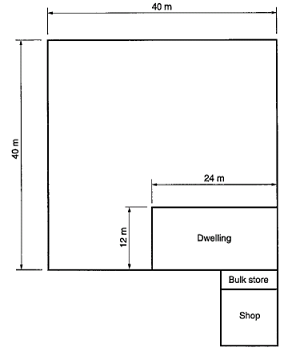
You are required to carry out a flea treatment job:
1. Using the 'Bugkill' label:
a) How much mix will you use in the yard (the yard is all dry and dusty)?
b) How much concentrate will you use in the yard?
c) Why can't you use 'Bugkill' inside the dwelling?
2. Using the 'Superkill' label:
a) How much mix will you use in the dwelling?
b) How much concentrate will you use in the dwelling?
Question 2: Using the 'Bugkill' label:
a) You need to spray 210 m2 for mosquitoes.
i. How much mix is required?
ii. How much concentrate will you use?
b) You need to prepare 30 litres of mix to control cockroaches. How much concentrate will you use?
c) The 4 external walls of this shed must be sprayed for flies.
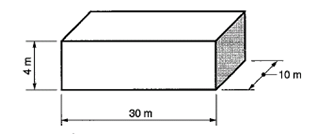
The dimensions of the shed are shown in the diagram.
i. How much mix is required?
ii. How much concentrate will you use?
iii. Why can't you use this product to treat for FLEAS internally on the concrete floor of the shed?
d) This yard must be treated for fleas.
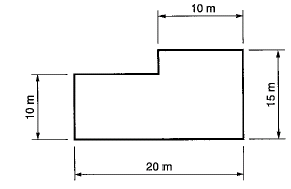
i. How much mix will be required?
ii. How much concentrate will you use?
e) The 4 external walls of this shed must be sprayed for mosquitoes.
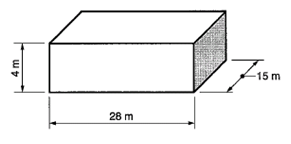
The dimensions of the shed are shown in the diagram.
i. How much mix is required?
ii. How much concentrate will you use?
f) You need to prepare 25 litres of mix to control ants. How much concentrate will you need?
Question 3: By using the 'Superkill' label:
a) You have to treat 200m2 for fleas (initial treatment).
i. How much mix is needed?
ii. How much concentrate is required?
b) You need to prepare 20 litres of mix for the initial cockroach treatment. How much concentrate will you use?
c) You are doing a maintenance treatment for ants and you have 15 litres of mix left. How much area (m2) can be treated for ants?
d) You must do a maintenance treatment for ants but you have only 75 ml of 'Superkill' left. How much area (m2) will 75 ml of 'Superkill' cover?
e) You need to spray the four exterior walls and two exterior gables of a shed for spiders.
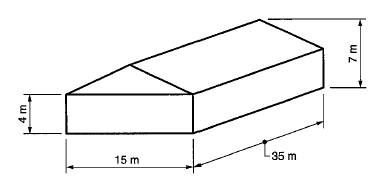
The dimensions are as follows.
Height from ground to top of gable is 7m.
The shed (without gable) is 15m wide (35m long x 4m high).
i. How much mix is required?
ii. How much concentrate will you use?
f) This yard has an infestation of fleas.
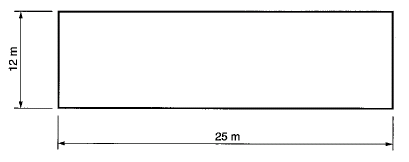
The dimensions are shown in the diagram.
i) How much mix is required?
ii) How much concentrate will you use?
Question 4: Calculate the following areas and volumes:
a)
i. Formula for the area?
ii. Area (show all workings)
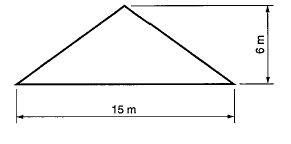
b)
i. Formula for the area?
ii. Area (show all workings).
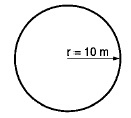
c)
i. Formula for the area of sides?
ii. Area of sides (show all workings).
iii. Formula for volume.
iv. Volume (show working).
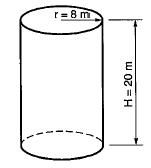
d)
i. Formula for volume.
ii. Volume (show working).
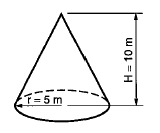
Manage Pests without Applying Pesticides Assignment Help service is devoted to offer the best online services to the students from all over the world who get distressed because of the anxiety of submitting the assignment tasks within the given time frame.
Tags: Manage Pests without Applying Pesticides Assignment Help, Manage Pests without Applying Pesticides Homework Help, Manage Pests without Applying Pesticides Coursework, Manage Pests without Applying Pesticides Solved Assignments, Life cycles and harbourages Assignment Help, Life cycles and harbourages Homework Help, Life cycles and harbourages Coursework, Life cycles and harbourages Solved Assignments
Attachment:- Manage Pests Without Applying Pesticides.rar